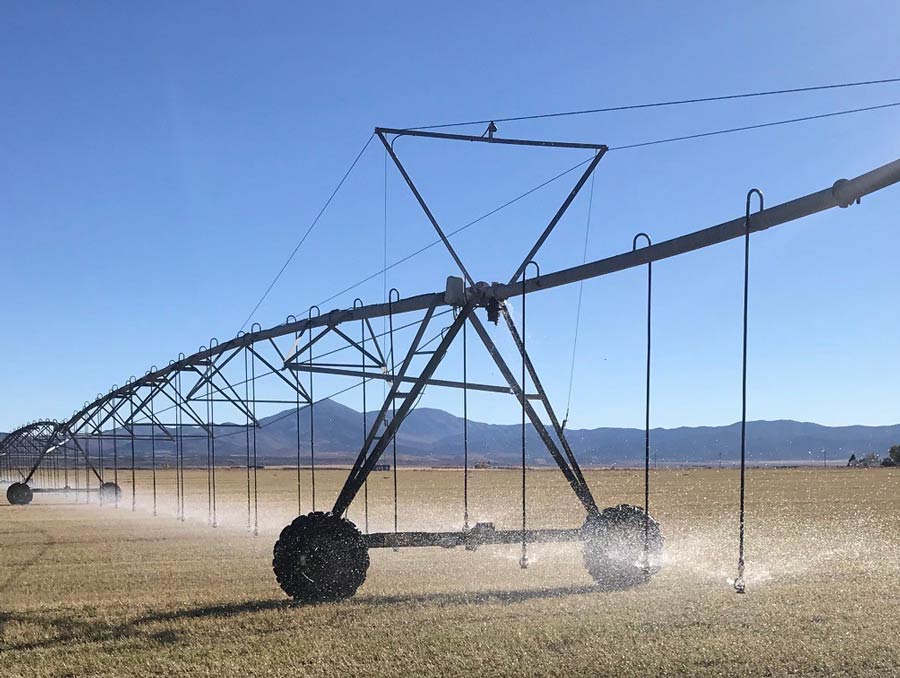At a ranch in Eureka, researchers are breeding a unique species of sheep well-adapted to the harsh Great Basin environment and that produces some of the finest wool in the nation. At the same time at a field in Fallon, researchers are using lasers and belowground radar to study how well sorghum grows with different levels of flood irrigation. And at a lab in Logandale, researchers just finished a study on how cactus pear can be grown as a commercial crop to fuel vehicles and feed both animals and people. These are just three of many projects happening at Experiment Station facilities across Nevada.
The Experiment Station is the research unit of the University’s College of Agriculture, Biotechnology & Natural Resources. It maintains a network of field stations throughout the state, providing researchers different environments where they can experiment on a larger scale while supporting the needs of the nearby communities.
“I think it’s really an exciting time for the Experiment Station, as our research is expanding throughout the state and our faculty are heavily engaged in projects that will serve to help our stakeholders in all areas of Nevada,” Chris Pritsos, director of the Experiment Station, said. “We’re really expanding our research capacity throughout the state. Our faculty have gone out and successfully competed for grants to support their work, and we are making significant impacts, whether it be in the area of water, agriculture production, environmental science or the cattle industry.”
Below are some of the projects occurring at the different field stations, including a few projects done in partnership with the College’s Extension unit and other organizations.
Logandale Research & Extension Center
The Experiment Station’s Logandale Research & Extension Center, located in Logandale in Clark County, was home to a recently concluded five-year study looking at cactus pear as a biofuel source and a sustainable food and forage crop. Results of the study, led by Biochemistry & Molecular Biology Professor John Cushman, show the plant may be able to provide fuel and food in places that previously haven’t been able to grow much in the way of sustainable crops. In addition, when the cactus pear is not being harvested for biofuel, then it works as a land-based carbon sink, removing carbon dioxide from the atmosphere and storing it in a sustainable manner. The published results were co-authored by Associate Professor and Extension Educator in Logandale Carol Bishop, postdoctoral research scholar Dhurba Neupane, and biochemistry graduate students Nicholas Alexander Niechayev and Jesse Mayer.
Among three cactus varieties researched by the University as drought-tolerant crops for biofuel, Opuntia ficus-indica produced the most fruit while using up to 80% less water than some traditional crops. Photo by John Cushman.
Additional research at the lab includes a study of 19 varieties of pomegranates – varieties that researchers believe have never been grown in southern Nevada before.
Research Center & Demonstration Orchard
Much of the Experiment Station’s research is shared between northern and southern Nevada, as the goal is to find crops that work in both the Great Basin and the Mojave Desert regions. Biochemistry Professor Grant Cramer and Associate Professor and Extension Horticulture Specialist M.L. Robinson conducted one such study at the Research Center & Demonstration Orchard in Las Vegas on hybrid grape varieties. The study, also performed at the Valley Road Field Lab located at the University’s main campus in Reno, had positive results, showing that many wine grape varieties studied work well in both northern and southern Nevada. In addition, many of the varieties grew exceptionally well without needing fertilizer, and some have been provided to local winemakers.
The Demonstration Orchard, part of the University of Nevada, Las Vegas’s Center for Urban Water Conservation in North Las Vegas, has been a cooperative effort between Extension and the University of Nevada, Las Vegas for over 25 years. The orchard has over 800 fruit trees and grapevines, vegetables and other row crops being tested for their ability to survive and produce under desert conditions. In addition, homeowners and commercial producers can attend classes or take tours at the orchard periodically throughout the year.
Gund Ranch Research & Training Center
The Experiment Station’s Gund Ranch Research & Training Center, 10,600 acres located 45 miles northeast of Austin in Elko County, is the only Experiment Station facility with a public lands grazing permit for about 90,000 acres alongside private grazing land. It maintains an active commercial cattle herd, which provides the University with insight into the same challenges and issues that other producers using public lands face.
“The ranch is treated like other commercial livestock production services, but also has the research component,” Ranch Manager and Staff Research Associate Jon Wilker said. “It has to adhere to the rules and regulations of federal grazing, which provides a unique opportunity to do research on a commercial livestock herd grazing on public lands.”
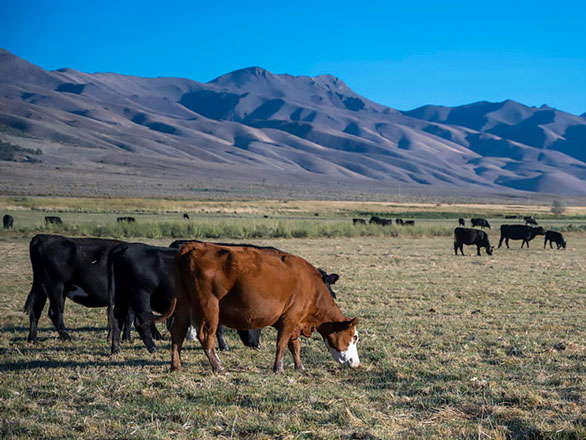
The Gund Ranch Research & Training Center maintains an active commercial cattle herd, which provides the University with insight into the same challenges and issues that other producers using public lands face. Photo by Robert Moore.
Past research includes investigating soil microbes after range fire, and studies on cheatgrass and timing of grazing to control noxious weeds. Current studies include ongoing research with grazing and heifer development, and monarch butterfly and milkweed interactions.
In addition, the Ranch is involved in the U.S. Department of Agriculture’s Legacy Ranch Project. The department’s Agricultural Research Service is building a large database with information tracking the livestock production industry over the years. Data from several ranches nationwide span multiple metrics on different factors that have an impact on livestock producers, such as conception rates, weaning rates and changes in cattle prices. The Ranch has 13 years of livestock records to contribute, and continues to add more. In addition, the Ranch has a National Weather Service site on the property, so they can also provide information on how weather data is tied to these metrics.
Great Basin Research & Extension Center
In September of 2020, the Experiment Station opened the Great Basin Research & Extension Center. This 644-acre ranch in Eureka County’s Diamond Valley maintains a herd of sheep for research and funding. In addition, they plan to expand into research for crops, rangeland maintenance and other issues of local interest. The Center is operated in partnership with Extension.
New Experiment Station & Extension Facility
Rafter 7 Sheep, developed through the Experiment Station, drink water in Eureka County. Photo by Gary McCuin.
Read about the Great Basin Research & Extension Center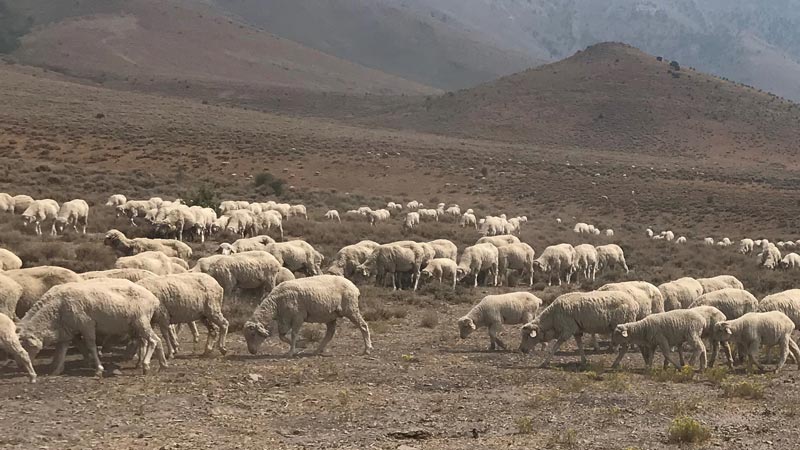
One of the existing projects at the Center is investigating ways to help domestic sheep and wild bighorn sheep coexist by reducing the spread of Mycoplasma ovipneumoniae, which is often fatal to wild bighorns. The Nevada Department of Wildlife currently prevents the spread of the disease by prohibiting domestic grazing in rangeland spaces too close to wild herds, as wild bighorns don’t discriminate between domestic and wild when building their herd and establishing their territory.
The project, done in partnership with the Nevada Department of Wildlife, aims to breed Rafter 7 sheep, which are world-renowned for both their wool and their meat, to be resistant to the disease. The Rafter 7 breed itself was originally developed 30 years ago through Experiment Station research under the direction of the College’s Hudson Glimp, professor emeritus of animal biotechnology.
“If we can develop a genetically resistant herd, then we can reduce the harmful interactions between the [domestic and wild herds] and potentially increase the habitat range for both in Nevada and across the West.” – Gary McCuin.
Center Director Gary McCuin, who is also Extension educator in Eureka County, said there are plans to study using sheep to reduce larkspur on grazing rangeland as well, as the plant is fatal to cattle. The herd will also help fund the Center through annual sheep sales and the sale of wool products. Currently, Mountain Meadow Wool in Buffalo, Wyoming, is producing value-added wool products to sell to University alumni and through the University’s Nevada Wolf Shop, and McCuin is working with local businesses to sell the products as well.
This summer, the Center will also be one of three Experiment Stations involved in a sorghum and irrigation study. Associate Professor Robert A. Washington-Allen and Assistant Professor Manuel Alejandro Andrade-Rodriguez, both with the College’s Department of Agriculture, Veterinary & Rangeland Sciences, are adding a variable rate irrigation system to a center pivot irrigation system. The variable rate center pivot will allow the application of different watering levels to plots at the Center to study how different sorghum varieties respond to full (no water stress) and deficit (moderate and severe water stress) irrigation treatments.
“The variable rate system allows you to control individual sprinklers of a center pivot to control how much water you’re applying to different areas of the field,” Andrade-Rodriguez said. “To the best of my knowledge, this is the first time that a variable rate irrigation system will be used in Nevada.”
Since the Center is far from the other two involved stations, the team is experimenting with using internet-connected sensors to collect and transmit via Wi-Fi hourly soil moisture data that can be accessed from the Valley Road Field Lab.
Valley Road Field Lab
As part of the same study, the Valley Road Field Lab is the testing ground for precise irrigation management using a drip irrigation system. Additional team members at Valley Road include Assistant Professor Melinda Yerka, also with the Department of Agriculture, Veterinary & Rangeland Sciences, Assistant Professor and Extension Field Crop Specialist Maninder Walia, and graduate students Russell Godkin (animal and rangeland science), John Baggett (biochemistry), Anil Kunapareddy (molecular biology) and Uriel Cholula-Rivera (environmental science).
The team is using a variety of technologies for the sorghum irrigation project, including internet-connected soil moisture-sensing stations, ground-penetrating radar (GPR) and terrestrial laser scanners to measure the effects of the different irrigation methods on traits of sorghum during normal and drought conditions, including root depth, plant height and biomass. For both Valley Road and the Center, the team is also using drones.
“Use of this technology is cutting edge,” Washington-Allen said. “GPR in particular is known for forensic use to find burial grounds and excavation areas. Early on, we pioneered the use of it for mapping out the root systems for wheat and potatoes. GPR is an exciting technology for dryland agriculture, because it allows us to detect and map the root systems of crops and estimate their biomass at different times without digging them up. This is a particularly important technology for rangelands where up to 80% of the plant biomass is below ground, but we tend to focus our monitoring and research on the 20% that is aboveground.”
In addition to providing pasture space to experiment with the technology, the 27 acres at Valley Road also house three state-of-the-art research facilities, including a 29,280-square foot Greenhouse Complex, biofuels research facilities and the Valley Road fermentation lab. Additional assets include eight tunnel hoop houses, an 18-acre equestrian facility and a fully equipped maintenance engineering shop.
Other large projects at Valley Road include investigating the malting and brewing of sorghum, led by Yerka and Baggett, and studying teff for small grain production, led by Walia. Teff has been studied at the Experiment Station at least since 2006, when Extension's Professor Emeritus Jay Davison began trials that got farmers interested in the crop. Cushman, with graduate student Mitiku Mengistu (biochemistry), is studying teff’s genetics to identify which traits help the plants increase their yield while being drought resistant.
Graduate Student Mitiku Mengistu (left) and Professor John Cushman study teff to identify which traits help increase yield while being drought resistant. Photo courtesy of Nevada Silver & Blue.
With this knowledge, he is developing varieties in the Valley Road greenhouse that will be better suited for Nevada growing conditions. Both Walia and Solomon are testing these varieties in a number of these field conditions at the larger farm scale.
“Teff is more drought tolerant and nearly three times more water-efficient than more traditional crops such as alfalfa.” - Cushman.
“Farmers can get hay from teff, and teff grain is in high demand and sells for a premium price because it is high in protein, iron and amino acids and is gluten free, among other benefits,” Cushman said.
Walia is conducting additional alternative crop research as well, investigating soybeans, camelina and mung beans for various purposes, including grain production for human consumption and biofuel production, cover crops for suppressing weeds, and livestock feed.
Desert Farming Initiative
The Valley Road Field Lab is also home to the Experiment Station’s Desert Farming Initiative, which conducts research, provides hands-on learning for both undergraduate and graduate students, and donates and sells certified organic produce to the community.
One of the larger research projects is a three-year study to identify which cantaloupe and honeydew varieties are most suitable for commercial production in northern Nevada. The project is entering its first season and is being conducted in partnership with Assistant Professor of Sustainable Horticulture Felipe Barrios-Masias, Extension’s Associate Professor and Horticulture Specialist Heidi Kratsch, and Extension Horticulturist and Plant Diagnostician Wendy Hanson Mazet. Additional projects at the Initiative include an examination of summer cover crop rotation focusing on Sudan sorghum grass mix and Sunn hemp.
The Initiative also offers a Food Safety Program, which aims to prevent foodborne illnesses on farms in Nevada. The demonstration farm and five-year program provide support to local producers through its website, workshops, trainings and farm visits.
In 2020, as a result of COVID, the Initiative helped found a Food Security Coalition to address the growing demand at food pantries. The farm produced over 20 tons of vegetables, which were sold to regional food hubs, restaurants and farmers markets. With grant funding and donations, a portion of that harvest was also directed to food pantries, including the University’s Pack Provisions, while following COVID-19 procedures. The Initiative plans to do the same this year and is running a crowdfunding campaign to expand this Farm-to-Food Pantry Program.
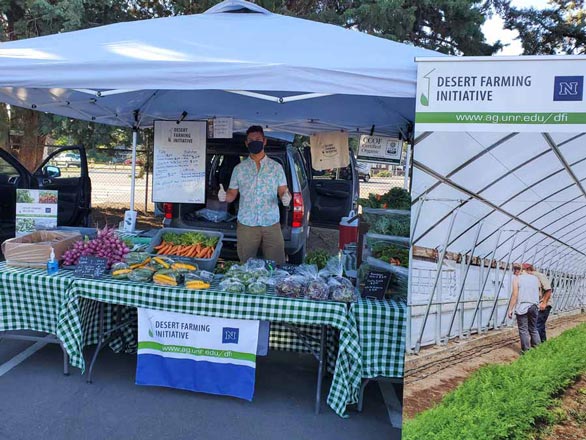
Student employee Everett Cook sells organic produce for the Desert Farming Initiative. Photo by Charles Schembre.
“We’re providing over 90 varieties of certified organic fruits and vegetables to the community every year,” said Jill Moe, education program coordinator with the Initiative. “We also sell over 100,000 plant starts to local growers annually to jump-start the growing season.”
In addition, the Initiative offers subscription boxes with their Farm Share Program for College students, staff and faculty. Subscribers receive weekly boxes filled with seasonally grown vegetables, herbs and fruits.
Fallon Research Center
The Fallon Research Center is located in Churchill County and houses the U.S. Department of Agriculture Natural Resources Conservation Service’s Great Basin Plant Materials Center. This 160-acre farm is the third station involved with the sorghum and irrigation project, with researchers testing how flood irrigation impacts sorghum at the different irrigation levels.
The station is also home to several other sorghum projects, including a new project investigating herbicide-resistant sorghum hybrids, many of which were commercialized this spring. The team will assess the varieties for how well they tolerate the herbicides when being watered using flood irrigation.
Another project is looking at how various sorghum varieties grow in different Nevada soils. Fallon has some sodium-rich soils with high salinity and alkalinity, characteristics that affect how much water is available for the plant. Yerka, Washington-Allen and Walia, along with graduate student Erin Smith (animal and rangeland science) and the Plant Materials Center’s Chris Bernau and Mat Humphrey, are using the same remote-sensing technology to look at how sorghum’s roots interact with the soil and how these interactions impact whole-plant growth and development.
“Our work is aimed to help farmers make better decisions about what to plant, about which crops grow best on their specific soils, so they can have a more sustainable operation.” - Yerka.
In addition, Walia is conducting research on chickpeas, dry beans, soybeans, teff for forage and grain production, and forage soybeans, which are crops that have garnered interest from local producers.
Juan Solomon, associate professor of Agriculture, Veterinary & Rangeland Sciences, and Barrios-Masias are beginning work with a local company to test the best growing conditions for several varieties of hemp for both fiber and seed production. Hemp production is rapidly expanding throughout the U.S. and may provide farmers with another alternative low-water crop. Initial results indicate Nevada has a climate well-suited for growing some hemp varieties.
Solomon is also studying the use of silage sorghum to provide feed for dairy operations in Nevada. Silage is what’s left after the harvested crop, such as corn, alfalfa or soybeans, is fermented and stored. Dairy operations rely on silage to feed their cattle throughout the year, and if Nevada operations cannot get silage with enough protein and energy locally, then they buy from out of state.
For producers growing alfalfa, the crop is harvested three to four times throughout the year, with the third or fourth cut being a valuable option for mixed silage. However, sorghum silage by itself has low levels of protein. Certain sorghum crops are ready to harvest when alfalfa is ready for its third cut, so when the two are mixed together, the alfalfa increases the protein in the resulting silage.
“The goal is to find alternative feed crops that use less water and fertilizer than more traditional silage crops, such as corn,” Solomon explained. “By incorporating the third-cut alfalfa into the sorghum, we boost the protein value of the silage to meet the demands of the dairy industry.”
Sorghum can be grown together with soybeans and cowpeas as well, and when the plants are ready to harvest for silage, the soybeans and cowpeas enhance the protein value.
Sorghum is being bred and studied for multiple projects, including brewing beer and feeding livestock. Photo by Maninder Walia.
Main Station Field Lab
Solomon is also growing silage sorghum at the Main Station Field Lab, more than 800 acres located in east Reno. In a separate project, he is investigating alternative methods for growing plants in grazing pastures for livestock. Traditionally, producers grow a mix of forage grasses with legumes, which are broadleaf plants that have higher nutritional value than grasses and produce nitrogen that the grasses use. The problem is cattle prefer eating the legumes before the grass, which throws off the nitrogen balance and uses up the legumes within the first two of the five years the mixture is intended to last.
Solomon is investigating using a special system approach, where the grasses and legumes are grown next to each other in a patchwork pattern, rather than mixed together. Such a pasture would allow animals to easily choose which component they want to graze, the legumes and grasses can maximize their growth without having to compete for growth resources, and it’s easier to control grass weeds in the legume patches and broadleaf weeds in the grass patches. As for the nitrogen, producers would only have to fertilize the grass in half of the pasture, rather than the whole pasture. In addition, the crops can be rotated every five or six years, moving the grass into the legume areas and the legumes into the grass areas. Preliminary results of the study show greater cattle daily weight gain with the special system compared to the traditional mixed pasture.
In another project at Main Station, Assistant Professor of Beef Cattle Production Mozart Fonseca is leading a team in researching the use of brewery waste as cattle feed. Fonseca, along with Amilton de Mello, assistant professor of meat science, analyzed the different and unique nutrient profiles from wastes collected from breweries in Reno and Carson City. They discovered that wastes from different craft brews can have different effects on the cattle meat, and they want to know if feeding specific brew waste to cattle can create “craft meat” in the same way that specific grapes can create specific wine. In addition, Fonseca and de Mello are working with Staci Emm, professor and Extension educator in Mineral County, and Bishop to evaluate the economic feasibility of using the spent grains to supplement on-farm resources and help sustain farming operations when available feed is limited. Emm and Bishop will also be establishing an advisory group for the project and are educating producers and craft brewers about the possibility of using the waste as feed.
“We are creating the environment so producers can communicate with the community,” Fonseca said. “The idea is the beer crafter sells burgers and steaks branded by their beers so we can improve overall local industry sustainability with turning waste into a grow-local product.”
Fonseca and de Mello are also investigating several different ways to help cattle producers maintain their herd and keep their production operations economically viable when food and water for livestock are limited. Examples include testing supplements to see if livestock will voluntarily drink less water, evaluating the offspring of cattle who lost weight then regained it quickly because of fluctuations in food availability due to events such as wildfires or drought, and researching if animals’ drinking behavior may affect how much and where they choose to graze.
“Many new hypotheses are being explored right now,” de Mello said. “We used to stick with what we knew, but the technology allows us to go deeper into things we were not able to do before.”
Wolf Pack Meats
Main Station is also home to the Experiment Station’s Wolf Pack Meats, one of only two meat processing plants in Nevada capable of providing U.S. Department of Agriculture-inspected harvesting services to local farmers. The facility maintains its own herd, which it uses to study ways to produce meat in greater quantities with higher quality.
Over the past year, Wolf Pack Meats, under the direction of de Mello, has been collecting data from beef brought to the facility from producers in northern Nevada and California to determine the meat’s quality and yield amount. Their goal is to identify the possible gaps producers have in their commercial production operation, then use the data collected from the Wolf Pack Meats herd to fill these gaps with information about how producers can generate more beef of higher quality from one animal.
“Most of the beef is produced using a low concentration of grains,” de Mello, said. “We know grains are responsible for increasing the fat content in the lean and improving the flavor. Our goal is to help producers improve beef quality, generate more profit and give a better experience to consumers.”
During the height of the COVID-19 pandemic, with meat processing plants around the country shutting down and making it difficult for ranchers to slaughter and process their cattle, thus creating a meat shortage nationwide, Wolf Pack Meats implemented strict regulations and remained open. According to Pritsos, Wolf Pack Meats increased its slaughter and production by more than 20% to help ranchers and increase the local meat supply.
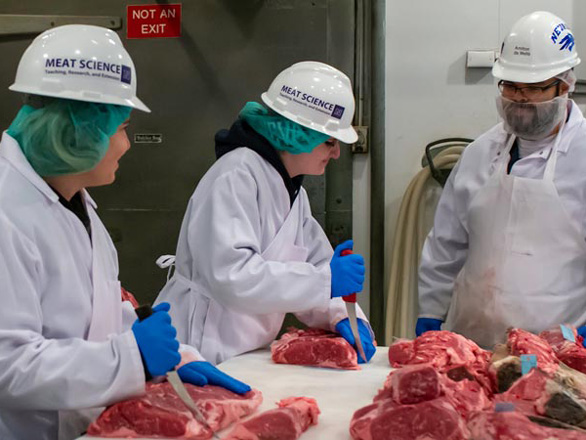
Wolf Pack Meats Director Amilton de Mello presents students with real-world learning experiences in a functioning commercial facility. Photo taken prior to March 2020 by Robert Moore.
In addition, the facility has undergone several years of renovations and upgrades to meet commercial meat and processing standards to ensure food safety, as well as to make the facility safer for employees and better designed for teaching activities for students.
“Wolf Pack Meats has undergone a tremendous series of upgrades and renovations over the past few years with the intent to increase the safety of workers, staff and animals, provide our students with state-of-the-art equipment for training, and provide a demonstration center for stakeholders to learn about the latest in meat processing,” Pritsos said.
The most recent changes include new compressors and new holding pens using a practical design to reduce the risks posed to employees for moving animals.
Whittell Forest & Wildlife Area
The Whittell Forest & Wildlife Area is actually administered by Research & Innovation at the University at the University, but Experiment Station faculty are heavily involved in its operations. This 2,650-acre forest on the western edge of Washoe Valley in Washoe County supports experiential learning, research and creative activities by faculty and students across multiple disciplines and throughout the Nevada System of Higher Education. Many Experiment Station faculty conduct wildlife and habitat research there, and Assistant Professor Sarah Bisbing, with the department of Natural Resources & Environmental Science, serves as the area’s director and chair of the advisory committee. In addition, the area also recently saw several enhancements, including $250,000 from the Experiment Station to allow projects such as establishing a groundwater well and remote weather station, and refurbishing a rustic cabin and camp area.
Jay Dow Sr. Wetlands
The Experiment Station’s facilities also extend beyond Nevada’s borders. The Jay Dow Sr. Wetlands are located near Herlong, California, and the approximately 1,360 acres have been used for wildlife research, including the investigation of migratory waterfowl. The wetlands are currently undergoing some major renovations, including automated and remotely monitored irrigation systems, which will support both research activities and hay production on approximately 250 acres. Additionally, this site supports livestock grazing and is a valuable part of the rotational grazing system for the Experiment Station’s commercial beef herd at Main Station.
